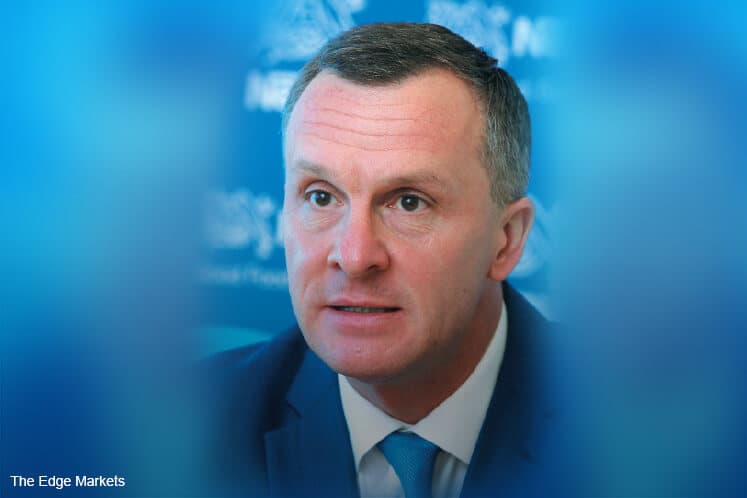
HEADWINDS from rising commodity prices and the weak ringgit are not enough to dampen growth at Nestlé (M) Bhd. The food and beverage company, which has been growing earnings at strong single-digit rates for the past two consecutive years, expects to keep the growth momentum going in the financial year ending Dec 31, 2017 (FY2017).
“I would love it if we can have single-digit growth this year. A 5% growth rate is considered to be good in a flattish environment,” says its CEO Alois Hofbauer, but adds that the group does not make forward-looking statements.
“What’s more important for us is to be able to deliver sustainable profitable growth year on year. We want to grow our top and bottom line in a sustainable manner,” he tells The Edge in an interview.
After slipping 2% in FY2014, Nestlé Malaysia’s net profit rose for a second straight year in FY2016, rising 7.9% y-o-y to RM637.13 million. Net profit grew 7.3% y-o-y to RM590.73 million for FY2015.
“Last year was challenging due to the spillover effects of the Goods and Services Tax. However, we managed to outperform all our targets,” says Hofbauer.
He attributes the gains to the group’s strategy of investing during challenging times.
“In 2013, we created a programme called FIT, which stands for fuel, innovate and transform.
“Every year, we set performance targets for the group and our employees to generate productivity gains and cost savings, which will be reinvested in the group. Last year alone, the programme resulted in savings of RM197 million, which was reinvested in the business, allowing us to keep our margins strong,” he says.
“As a global business, we also benefit from economies of scale. We have global procurement hubs where we buy and hedge [raw material costs]. So that gives us an advantage over local and regional players.”
This year, Nestlé Malaysia faces the prospect of rising input costs as prices of key commodities, such as sugar, coffee beans and milk, have been rising, which could put pressure on it to increase the prices of its products.
“Commodity prices have come down for the past two years and are starting to pick up,” Hofbauer says. “Clearly, not all [costs] can be absorbed. So there will be occasional price increases and [if that happens, it will be done] in the most sensible manner. The increases will be done selectively and not across the board.”
The depreciation of the ringgit against the US dollar is also worrying Nestlé Malaysia as it translates into higher procurement cost for raw materials.
However, looking at the group’s performance in FY2016, Hofbauer is confident that it can deliver another year of progress.
“We have demonstrated that we can produce strong results [even in challenging times]. Top line growth [for FY2016] was close to 5% — crossing the RM5 billion mark for the first time — while the bottom line was up 8%. We paid a record high dividend [of RM2.70 per share] and strengthened our market share , while 10% of our domestic sales was driven by new products. So, I am very bullish about our prospects,” he says.
The group expects production efficiencies and improved margins to drive earnings growth this year as it adds value to its products.
“We continue to look for ways to add value to our products for our customers. While most of our products have been around for generations in Malaysia, we try to give consumers better value y-o-y,” says Hofbauer.
Nestlé Malaysia will also continue to invest substantially in its brand this year.
“Last year, we spent RM500 million on advertising, excluding digital marketing. We have raised our advertising spend y-o-y and are today one of the top three advertising spenders in the country,” Hofbauer says.
Nestlé Malaysia will also continue to grow its e-commerce business this year.
Hofbauer notes that e-commerce accounted for only “a few hundred thousand ringgit” of the group’s revenue two years ago, which he deems insignificant, but this grew to over RM10 million last year. The target for this year is to increase it to RM40 million to RM50 million.
“My target is for online sales to eventually account for at least RM500 million, or 10% of total revenue, but I can’t give you a timeline,” he says.
In October last year, Nestlé Malaysia joined hands with online retailers Lazada and 11street to set up its flagship e-commerce store.
Meanwhile, Nestlé Malaysia’s export business, which grew at a faster rate than domestic sales last year, is expected to continue its growth momentum this year as demand for halal-certified products continues to be on the uptrend.
Currently, exports make up 20% of the group’s total revenue. Its locally produced halal products are exported to affiliated companies in over 50 countries.
“There is an increasing demand for halal certified products because the Muslim population in the world is growing,” says Hofbauer.
Still, he notes that the downside risk to Nestlé Malaysia’s export growth is that once some of the markets in which it currently exports to have achieved critical mass, they will set up their own halal factories.
In the past 52 weeks, Nestlé Malaysia’s shares have traded at between RM73.82 and RM81.80, and closed at RM76.60 last Wednesday, valuing it at RM17.98 billion.
In a note to clients on Feb 28, CIMB says although it continues to like Nestlé Malaysia for its consistent earnings delivery, strong brand name and solid product mix, the stock is fairly valued for now.
“Upside risks include stronger-than-expected export demand and significant recovery in domestic spending, while downside risks include a substantial spike in raw material prices and/or US dollar versus the ringgit,” it adds.
Save by subscribing to us for your print and/or digital copy.
P/S: The Edge is also available on Apple's AppStore and Androids' Google Play.